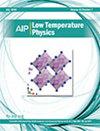H2O、D2O 和惰性物质相图的比较
IF 0.8
4区 物理与天体物理
Q4 PHYSICS, APPLIED
引用次数: 0
摘要
比较了轻 H2O、重 D2O 水和惰性物质(Ne、Ar、Kr 和 Xe)的相图。提出了一种选择熵和内能起点的方法。这种方法可以利用热量变量测试相应状态的原理。在给定的温度、压力和化学势坐标下,水的同素异形体形成一组物质,并具有相似的相图。相同坐标下的惰性物质组成另一组物质,具有相似的相图。具有重要德布尔量子参数的惰性 Ne 的相图与其他惰性物质的相图有一定程度的差异。本文章由计算机程序翻译,如有差异,请以英文原文为准。
Comparison of phase diagrams of H2O, D2O, and inert substances
The phase diagrams for the light H2O, heavy D2O water, and inert substances (Ne, Ar, Kr, and Xe) have been compared. A method of choosing the starting point for entropy and internal energy was proposed. It allowed testing the principle of corresponding states using caloric variables. In the given coordinates of temperature, pressure, and chemical potential, the water isotopologues form one group of substances and have similar phase diagrams. The inert substances in the same coordinates form another group of substances with similar phase diagrams. The phase diagrams for inert Ne with significant de Boer quantum parameters differ to a certain extent from the phase diagrams of other inert substances.
求助全文
通过发布文献求助,成功后即可免费获取论文全文。
去求助
来源期刊

Low Temperature Physics
物理-物理:应用
CiteScore
1.20
自引率
25.00%
发文量
138
审稿时长
3 months
期刊介绍:
Guided by an international editorial board, Low Temperature Physics (LTP) communicates the results of important experimental and theoretical studies conducted at low temperatures. LTP offers key work in such areas as superconductivity, magnetism, lattice dynamics, quantum liquids and crystals, cryocrystals, low-dimensional and disordered systems, electronic properties of normal metals and alloys, and critical phenomena. The journal publishes original articles on new experimental and theoretical results as well as review articles, brief communications, memoirs, and biographies.
Low Temperature Physics, a translation of the copyrighted Journal FIZIKA NIZKIKH TEMPERATUR, is a monthly journal containing English reports of current research in the field of the low temperature physics. The translation began with the 1975 issues. One volume is published annually beginning with the January issues.
 求助内容:
求助内容: 应助结果提醒方式:
应助结果提醒方式:


